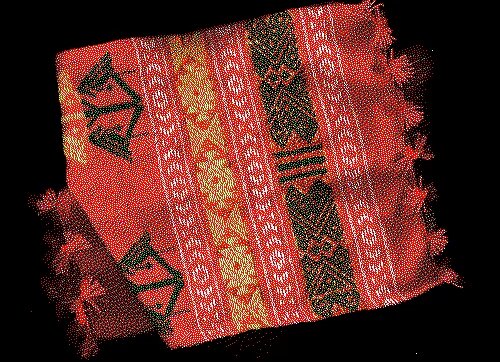

Opening gesture- Rediscovering “Indian-ness”
Working as a visual artist, I have been very conscious of the many traditions in Indian culture. I myself have felt at the cross-roads between these traditions. Folk culture in the form of the various crafts, and regional influences is a coming together of different social traditions. These ethnic traditions have shaped the way Indian society has developed as a complex mosaic of local cultures. In the Indian context of modernity, often in tension with traditional values, the importance of myths and rituals has been contrasted with a “scientific temper”. Here the inherent conflict of an urbanized society, and what might be termed “village India” is particularly acute. Gandhi stressed that at his time the majority of Indians were still part of a village economy, with the mindset that has supported the cultural ethos of a rural populace. This is no longer true as many from rural India have migrated to the big cities in search of work.
Traditional Indian folk culture from the point of view of the Indian artist, entails the folk imagination that is very much shaped by traditional myths and symbols. It is to be noted that by “folk culture” I am not referring to the popular culture that has been influenced by the film industry which is mainly concerned with popular entertainment, and has been used politically. The term “art” is one that the modern urban elite has adopted along with the idea of “design”, and also often serves the demands of a consumer market. Though Indian society has been sustained by handicrafts that are the mainstay of what Gandhi understood by “village industries”, these “industries” were originally linked primarily to a rural economy that was based in agriculture. In the village, despite various social tensions between castes, and religious beliefs and practices, one can find an underlying unity, which is a primal world-view that forms the backbone of Indian folk culture. This culture is something that the modern urban artist has often returned to in the hope of re-discovering authentic “Indian-ness”, which is very difficult to define, given the great diversity of Indian forms of cultural expression. It is here that the inherent conflict between a native understanding of nationalism, and the plurality of Indian cultural traditions, is most acute.
In my own engagement with Indian spiritual tradition, I have been concerned with the importance of the ashram ideal, in the context of indigenous approaches to learning and wholeness. In the nineteenth and early twentieth centuries’ there were efforts made by some intellectuals (Tagore, Gandhi, Aurobindo, and a few others) to re-interpret an ancient Ashram ideal. These experimental ashram communities tried to bridge an Indian tradition and a modern approach to education, while aiming towards the transformation of village life. The ashram also tried to find an “Indian” cultural context that responds to the spiritual diversity that characterizes multi religious communities. The word “sat-sangh” meaning the gathering of those searching for truth, was part of an ashram ideal, but was also associated with a dominant caste system, that was seen by the marginalized as linked to a spirituality that often was oppressive. However, the ashram did incorporate various values to be found in what is understood as a folk culture, based on handicrafts, healing practices, and a simple life style.
Symbolic elements in the folk imagination
A folk culture rooted in the Indian rural landscape, introduced to me a symbolic world that has nurtured village life. The agricultural practice of inter-cropping mixed varieties of seeds in a single field, was based on a cosmology that linked the earth with the vast sky overhead. A symbolic system that found in the microcosm a reflection of the macrocosmic universe, saw in the day-to-day practice of farming the land, a significance in the human effort to cultivate the earth, bound to the workings of a whole universe that governs the rhythms of the seasons. The seed buried in the furrowed soil, held in the folk imagination, the secret spark of life, mirroring a cosmic order that determines the movement of stars. This symbolic equation of living seed to the many bright points in the sky, was not based on a scientific world view, but on an intuitive understanding that what governs the heavens, is the same law that stimulates life and growth here on earth. The vast space that we can see in the sky is reflected here below in the ploughed field. Land and sky are bound together in the one system of life that makes sense of our universe.
This sense of unity between what is immediate, and tangibly present, and the vast cycles of time that rule infinity, is the basis for a mythic understanding of human culture. The patterns that the heavenly bodies follow are mysterious, and beyond the grasp of our ordinary human comprehension, but it is trusted that what regulates the cosmos, gives to the diversity of nature a meaning and purpose. Plurality is a recognized feature of life. For this reason, the field is planted with different seeds that are the basis of the fruits of the earth that nourish the life of the community. In the same way that food is tasty and satisfying to the palette, if it has variety in accordance with the needs of the body, what is sown in the field serves the bodily requirements of humans and beasts who depend on the soil for sustenance. This concept has been clearly recognized by folk cultures all over the world.
The fragmentary nature of living processes is given significance in the context of a greater wholeness. Diversity that is found everywhere in nature, points to a unitythat is the essence of life, embracing difference within a greater order. The daily practice of time honored ritual, represents a wisdom in the practices of a traditional society. It is in this light that the inter-cropping of plants was an accepted principle of balanced agriculture. A scientific rational behind this way of cultivating may be formulated, but its symbolic meaning was accepted long before the inter-connectedness of all life forms was recognized by ecology as a scientific discipline.
It has been suggested that the first impulse to worship, as a ritual of celebrating life, was inspired by the cycle of the sun and moon and other lights in the heavens above the earth. It is this cosmic rite, one that gives rise to the seasons and the daily rhythms that creatures follow instinctively, that is the foundation of a folk spirituality. The pattern of festivals, and the way in which human cultures respond to a living environment, is expressed through the joyous movements of dance, and a sense of grace that pervades what we recognize as harmonious. Beauty cannot be defined abstractly, or by laying down rational rules. Rather it is something intuited through a physical sense of well-being. That all movement is consistent with the movement that can be observed in the heavens above us, is something that all natural cultures have recognized. In the context of a village life, I have often remarked that despite social and religious differences, there is a unity that is provided by an elemental world-view. The natural environment has given to the cultural ethos of the village a kind of unity, which transcends social and religious boundaries. The rapid rise of urbanization that is intrinsic to a modern understanding of development, based as it is on an industrialization process that is largely controlled by a few capitalists, has disrupted the balance between nature and culture. It is also to be noted that it is because of the growing gap engendered by it between the rich and the impoverished, that communal disharmony has also increased, and religious differences can be exploited for political ends.
Relevance of an Earth affirming culture in relation to ecological concerns
Now, when we are faced with a climate crisis, we are struggling to find a sense of relatedness that includes difference and diversity. Unity is not something that can be imposed rationally. A human world-view tries to impose an order on the natural environment, which like artificial intelligence, follows the working of the human mind. Human intelligence tries to think rationally, increasingly ignorant of what lies beyond human reasoning. The field of human self-consciousness has no longer its foundation in a cosmic consciousness.
In a folk spirituality every field had its guardian, or “kshetrapala” (keeper of the field) seen as a presence that is other than what we can control. In the village fields around where I live north of Bangalore, this guardian of the field is thought to reside in a termite hill that grows out of the soil, apparently having a will of its own. It is said to have come from the earth itself, and according to local folk beliefs is thought to have a mind of its own, which listens to what is going on in the field near to it. Like the Greek idea of ‘Gaia’, the Kshetrapala symbolizes the consciousness of the living earth. The rational human culture which has developed out of techno-scientific culture, does not believe that the earth can listen and think.
We are trapped by a mechanistic thought process that only believes that conscious agencies come from human intervention. Yet a traditional culture ascribed consciousness to the whole cosmos, of which the human being is only a part. Modern human beings see the world not as a tangible reflection of the heavens, but as material resources from which humanity gains. We try to project onto nature a rational process which, because it only mirrors human reason, is unfortunately also limited by the instrumental ways in which we often think. Diversity is considered to be part of a fractal chaos. We contend helplessly with the unpredictable, over which we have no control. The center, as the poet T.S.Eliot put it, has fallen apart, and no longer holds the meaningful in its conscious grasp. Climate change has become a nightmare that effects a change in human consciousness.
An elemental voice
As an artist, I have always felt that there is a wisdom in folk culture. I have experienced in the process of creating an image, that it is not me who is deciding what the image should look like. Rather, there is a creative energy in the image itself. I am often surprised that the art work is speaking to me. It is as though the image has an intention of its own, which is beyond my conscious control. This is an intuition which is very understandable from the perspective of a folk culture. In the world of today, it is perhaps the task of the creative imagination, to discover a new centeredness in a universe of changing and challenging forces. The conceit of a human-hubris, driven by an arrogant presumption that we can explain how nature functions and consequently manipulate her for resources to serve our limited ends, is beginning to crumble as we realize that our power to understand the cosmos reaches conscious limits.
It is in this context that we come back to what we do through scientific technology, to the life spark that the seed represents. A traditional world view linked the significance of the seed to the power of sexuality. Polarities that form the basis of symbolic thought, embodying age old dichotomies such as good and evil, material as opposed to the spiritual, conscious as distinct from unconscious drives, have to be re-assessed in the light of history and what we understand of ethical standards. What we have tried to marginalize has to be brought back to re-invigorate what we believe is central. Intuition, and what we call “art”, provides a window that opens conscious awareness to what we have pushed into a liminal existence, as “Other” and irreconcilable. The “Other” cannot be reduced to a mere mirror image, that feeds back to us a virtual reality that is only a reflection of ourselves. We have to find a new way of respecting, and acknowledging the reality which is other than what we have come to accept as normative.
In an increasingly urbanized society, that is aspiring to become part of an international world-order based on a globalized economy that functions on the exploitation of natural resources, localized and rural cultural tradition(s) become increasingly marginalized. It is argued that unless those in a rural economy, shift to an urban context, the development of the masses will not be possible. In so called developed countries less than ten percent of the population is based on the land, and a rural way of life. The culture according to some, must be city oriented; that is how Civilization is understood.
Such a civil society, we are told, cannot be sustained by the kind of bio-diversity that characterized earlier forms of folk culture. Only by developing certain genetically modified seeds, that are high yielding, but need artificial fertilizers and chemical pesticides, can a growing population be fed. This is very much in favor of a centralized and capital intensive system of industrial agriculture, that is basically against local diversity. All this has its repercussions on the rich pluralism that characterized Indian culture.
The importance of an “Adi-Dharma”
It was in the mid-eighties that my interest in folk culture led me to reflect about an indigenous culture that goes beyond the values that we ascribe to civilization, and the development of an aggressively urbanized world. In 1987, I first met Dr. Ram Dayal Munda, who became Vice Chancellor of Ranchi University in 1985. He was an ardent supporter of a marginalized indigenous vision, which he called an “Adi Dharma”. For Ram Dayal Munda, culture is not opposed to nature, but is a creative response to the natural environment where we live. He tried to outline a moral code that was in harmony with this approach to culture. For him folk culture was part of a spiritual world-view that lies at the foundation of Religions, closely linked to the diversity of cultures found all over the world. However, those aspects of an “adi-dharma” that could not be assimilated into dogmatic religious systems have been termed animistic, and merely “primitive” or not “scientific”.
Working on myths and symbols in primal ‘indic’ traditions, I came to realize that pre-industrial societies had a vibrant visual culture. This material culture far predated mainstream village folk cultures. I have for many years been particularly interested in the form of what is called the “Mandala”, which simply means a circle. These mandala patterns are often associated with the work of women and are designs drawn on the threshold of the home, but are also essential features of festive decorations. The impulse to adorn, in relation to daily rituals that celebrate the circular rhythms of nature can be found as the basis of Indian aesthetics, called “alamkara”, meaning adornment.
The form of the wheel, linked to the sun, can be found in Neolithic rock shelters. Like the discovery of making fire, the invention of the wheel goes back to the very origins of language and culture. Geometric patterns, linked to cosmic symbols are found in primeval art around the world, and have been termed “archetypal”. In India, Tantric“yantra” designs combine various geometric forms within a containing circle, like the “shri-yantra” that has from ancient times been used as an aid to meditation. Here we find diversity brought within the ambit of an over-all unity.
The human ability to narrate stories is thought to be part of our effort to “make meaning”. Traditionally, however, it is the landscape that holds the key to all cultural narratives. Myths are the way we “sing” the land. Oral cultures have found their books inscribed in the features of the land. Kabir Das, the 15th-century Indian mystic poet and saint questions: “Where have you come from? Ask your body!” Language originates in the non-verbal. Trees, rocks, and other natural forms have their stories to tell. The body with its dance movements and gestures, is the original source of myth and legend. It is with our physical senses that we remember. It is in this sense that we speak of a visual, nonverbal material culture.
The form of the Mandala is like an aura or light that radiates from its centre. This centre is called the “bija”, meaning that which is “born again”. It is not without reason that the genetically modified seed is not self-generating. ‘Self-generating’ would mean that life is beyond the control of human science. The mandala is like a seed covering enclosing the germ of life. Mandalas interconnect, weaving together a web of Mandala Patterns.
Disclaimer: This article was prepared with the support of the Heinrich Böll Stiftung India. The views and analysis contained in the publication are those of the author and do not necessarily represent the views of the Heinrich Böll Stiftung/and the author's affiliated institution.






